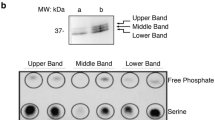Summary
We have recently shown that activation of protein kinase C by tumour promoting phorbolesters, such as 4β-β-phorbol-12,13-dibutyrate, stimulates adenosine-induced accumulation of cAMP in 7urkat cells, a human T-leukaemia line. Activating the CD3 complex associated with the T-cell receptor by means of the monoclonal antibody OKT3 caused a concentration-dependent accumulation of inositol phosphates and an increase in the phosphorylation of an endogenous protein kinase C substrate. OKT3 also mimicked the previously reported effects of protein kinase C since it potentiated the cAMP stimulation by either an adenosine analogue, NECA, or cholera toxin. Thus, our results indicate that stimulation of a receptor activating phospholipase C and protein kinase C can secondarily enhance the action of agonists that act on adenylate cyclase-coupled receptors.
Similar content being viewed by others
Abbreviations
- cAMP:
-
cyclic adenosine-monophosphate
- NECA:
-
5′-N-ethylcarboxyamido adenosine
References
Averill LE, Stein RL, Kammer GM (1988) Control of human Tlymphocyte interleukin-2 production by a cAMP-dependent pathway. Cell Immunol 115:88–99
Beckner SK, Farrar WL (1986) Interleukin-2 modulation of adenylate cyclase: potential role of protein kinase C. J Biol Chem 261:3043–3047
Berridge MJ, Dawson RMC, Downes CP, Heslop JP, Irvine RF (1983) Changes in the level of inositol phosphates after agonist-dependent hydrolysis of membrane phosphoinositides. Biochem J 212:473–482
Brown BL, Albano JDM, Ekins RP, Sgherzi AM, Tampion W (1971) A simple and sensitive saturation assay method for the measurement of adenosine 3,5-cyclic monophosphate. Biochem J 121:561–562
Fredholm BB, Sollevi A (1986) Cardiovascular effects of adenosine. Clin Physiol 6:1–21
Friedrich B, Noreus K, Cantrell DA, Gullberg M (1988) Activation dependent phosphorylation of endogenous protein kinase C substrate in quiescent human T-lymphocytes. Immunobiology 176:465–478
Goldsmith MA, Weiss A (1988) New clues about the T-cell antigen receptor complex function. Immunol Today 9:220–222
Hollingsworth EB, Sears EB, Daly JW (1985) An activator of protein kinase C (phorbol-l2-myristate-13-acetate) augments 2-chloroadenosine-elicited accumulation of cyclic AMP in guinea pig cerebral cortical particulate preparations. FEBS Lett 184:339–342
Laemmli UK (1970) Cleavage of structural proteins during the assembly of the head of bacteriophage T4. Nature 227:680–685
Lerner A, Jacobson B, Miller RA (1988) Cyclic AMP concentrations modulate both calcium flux and hydrolysis of phosphatidylinositol phosphates in mouse T lymphocytes. J Immunol 140:936–940
Manger B, Weiss A, Imboden J, Laing T, Stobo JD (1987) The role of protein kinase C in transmembrane signalling by the T-cell antigen receptor complex. J Immunol 139:2755–2760
Ng J, Fredholm BB, Jondal M, Anderson T (1987) Characterization of PHA and anti-T3 induced transduction mechanisms in a human T-cell leukemia. Int J Immunopharmacol 9:17–22
Nishizuka Y (1986) Studies and perspectives of protein kinase C. Science 233:305–312
Nordstedt C, Fredholm BB (1987) Phorbol-12,13-dibutyrate enhances the cyclic AMP accumulation in rat hippocampal slices induced by adenosine analogues. Naunyn-Schmiedeberg's Arch Pharmacol 335:136–142
Nordstedt C, Jondal M, Fredholm BB (1987) Activation of protein kinase C inhibits prostaglandin- and potentiates adenosine-receptor stimulated accumulation of cyclic AMP in a human T-cell leukemia line. FEBS Lett 220:57–60
Nordstedt C, Kvanta A, Van der Ploeg I, Fredholm BB (1989) Dual effects of protein kinase C receptor stimulated cAMP accumulation in a human T-cell leukemia line. Eur J Pharmacol Mol Pharmacol Sect 1:51–60
Patel MD, Samelson LE, Klausner RD (1987) Multiple kinase in signal transduction: phosphorylation of the T-cell antigen receptor. J Biol Chem 262:5831–5838
Weiss A, Imboden J, Shoback D, Stobo J (1984) Role of T3 surface molecules in human T-cell activation: T3-dependent activation results in an increase in cytoplasmic free calcium. Proc Natl Acad Sci [USA] 81:4169–4173
Wiener E, Scarpa A (1989) Activation of protein kinase C modulates the adenylate cyclase effector system in B-lymphocytes. J Biol Chem 264:4324–4328
Yoshimasa T, Sibley DR, Bouvier M, Lefkowitz RJ, Caron MG (1987) Cross-talk between cellular signalling pathways suggested by phorbol ester induced adenylate cyclase phosphorylation. Nature 327:67–70
Author information
Authors and Affiliations
Additional information
The present study was supported by grants from The Swedish Cancer Association, The Swedish Medical Research Council (project no. 2553), by Gustaf V 80 Years Fund, by Nanna Swartz foundation and by Karolinska Institutet
Rights and permissions
About this article
Cite this article
Kvanta, A., Nordstedt, C., Jondal, M. et al. Activation of protein kinase C via the T-cell receptor complex potentiates cyclic AMP responses in T-cells. Naunyn-Schmiedeberg's Arch Pharmacol 340, 715–717 (1989). https://doi.org/10.1007/BF00169679
Received:
Accepted:
Issue Date:
DOI: https://doi.org/10.1007/BF00169679




